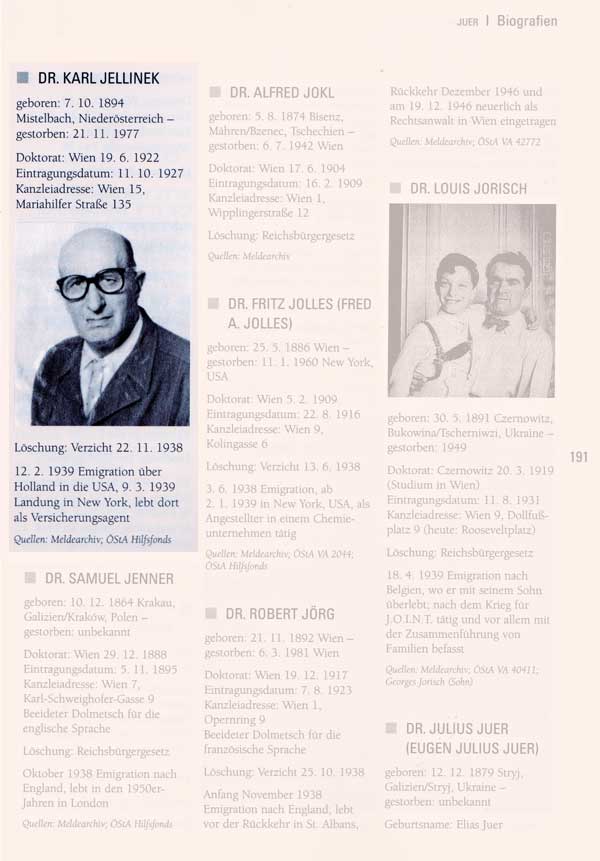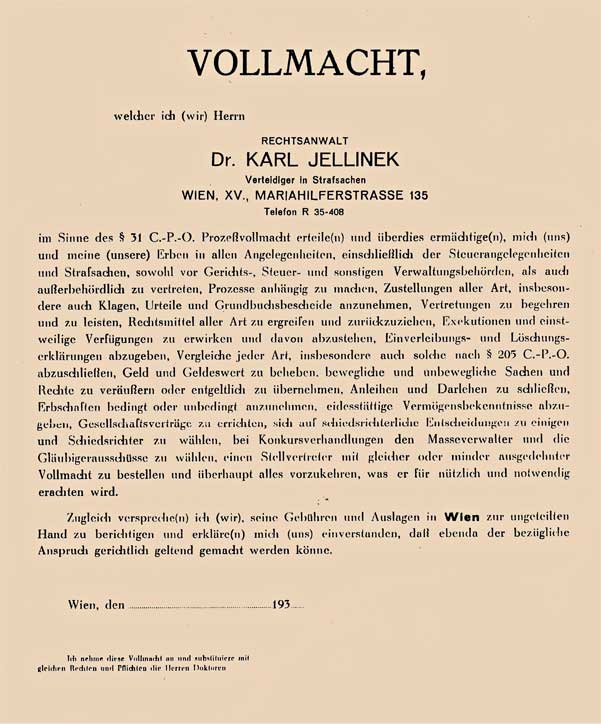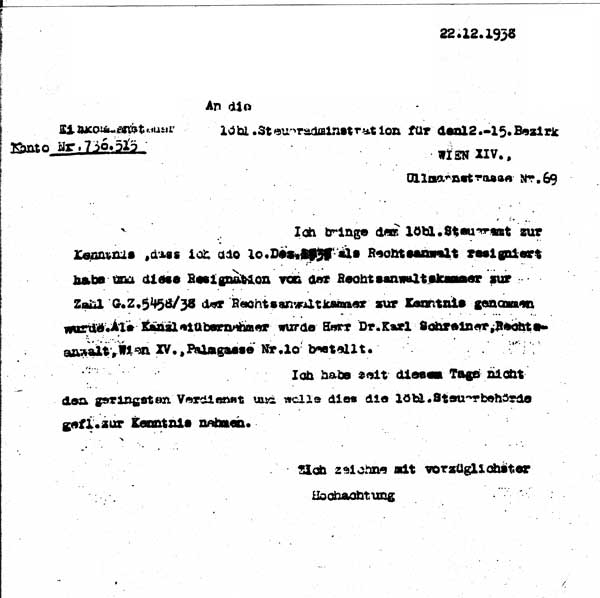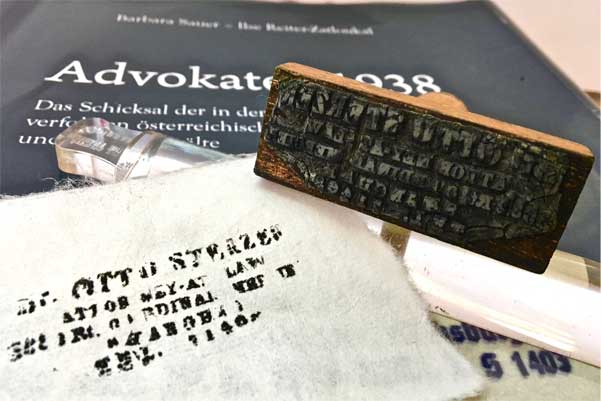


|
The first of these documents shows a page of the book Advokaten 1938: Das Schicksal der in den Jahren 1938 bis 1945 verfolgten österreischischen Rechsanwältinnen uind Rechsanwälte (Lawyers 1938: The Fate of Austrian Lawyers Persecuted in the Years 1938 - 1945). There is a photo of Dr. Karl Jellinek and basic biographical facts about his education and profession as a lawyer, as well as facts related to his disbarment by the Nazis. Advokaten 1938 provides the names and biographical information of 1,913 other attorneys persecuted by the Nazi regime. Karl Jellinek, was one of the 1,825 lawyers who were persecuted and disbarred solely because they were Jewish. English translations of key terms, descriptors and information: geboren - born gestorben - died Doktorat - Doctorate [of Law] degree, Wien - Vienna, [indicating The University of Vienna] Eintragungsdatum - registration or entry date; most likely into the Vienna Bar Association Kanzleiadresse - office address, Vienna’s 15th District, 135 Mariahilfer Street Löschung - [the stated reason for the] cancellation, disbarment, nullification or cessation; i.e., of one’s law practice, and of the right and license to practice law; Verzicht - renunciation, resignation; 22.11.1938 (cf. Karl’s report about his resignation to the tax authorities, shown below this document. Karl cited 10.12.1938 as the date of his resignation.) lebt dort als Versicherungsagent - lived there as insurance agent, (insurance broker) Quellen: Meldearchiv: OStA HIlfsfonds - Sources: Registration Archive, Austrian State Archive Relief Funds The Löschung (reason provided for the disbarment) of the majority of other Jewish lawyers remembered on the same page as Karl, as well as throughout the pages of Advokaten 1938, is the Reichsbürgergesetz - Reich Citizenship Law. This Nazi law, first enacted in September 1935, ultimately resulted in the disbarment of most of the Jewish attorneys listed in this book, because the law fundamentally derogated all Jews and deprived them of citizenship, political and civic rights. In addition, the law’s fifth ordinance, enacted in late September 1938, specifically prohibited Jews from practicing law. The Reich Citizenship Law was a part of the Nuremberg racial laws, that claimed that Jews constituted an inferior, pernicious race and therefore needed to be separated from and subordinated to people of “German or related blood.” The English language summary (pages IX - XIV in this otherwise German language book) states that : “At the end of September 1938, a law came into effect which allowed for all those persons who were classed as “full Jews” by the Nuremberg Race Laws to be struck from the lawyers’ rolls.” This decree resulted in the deletion of 1,466 Jewish lawyers from the registers of the Austrian bar associations in 1938. By officially resigning from his profession as a lawyer, Karl Jellinek may be considered part of an additional group of 359 Jewish lawyers whom the authors of Advokaten 1938 describe as having “. . . “voluntarily” renounced their right to practice.“ |


|
Karl’s personal copy of the Vollmacht document and of his report to the tax authorities of Vienna, informing them of his resignation and subsequent lack of income, are the second and third documents shown here. The Vollmacht’s provisions and connection to Karl’s December 22, 1938 resignation letter are summarized and explained, whereas Karl’s resignation letter to the tax authorities is fully translated below. 1 Vollmacht can be translated as proxy, and authorization, and is a document through which Karl was authorized as a lawyer in Vienna. Someone, (or some institution) authorized Karl to represent him (or it) and his (its) heirs in all matters, including criminal cases, legal matters of all kinds, all matters dealing with legal, administrative and tax authorities. Karl is authorized to take all means of legal redress, to evoke temporary injunction, appoint creditors, judges, etc. He basically can act in all ways which are open to a lawyer. Since the Vollmacht was attached to Karl’s letter attesting to his resignation from his profession as a lawyer, we can assume that the Vollmacht once authorized Karl as a lawyer in Vienna and that he simply cancelled it through his resignation, which is confirmed through his letter. December 22, 1938 Income Tax To the commendable inland revenue-department of the 12th - 15th District, Vienna XIV Ullmannstrasse No. 69 I inform the commendable inland-revenue deparment that I resigned from my profession as a lawyer on December 10, 1938, and that the Chamber of Lawyers took notice of this resignation at the (registration ) number G.Z. 5458/38. Mr. Dr. Karl Schreiner, lawyer, Vienna [district] XV, Palmgasse NO. 10, was appointed the successor in my lawyer’s office. Since that day, I have not earned any income, if the commendable inland revenue-department could take notice of that. Yours respectfully, It was most probably necessary for Karl to submit this report, in order for him, in turn, to obtain the “Certification from the local tax office,” which was one of the many documents required for “Emigration from the German Reich After 1937.” In addition, although “Proof of Permission to Leave Germany” wasn’t officially one of the many separate documents required for immigration to the US until after September 30, 1939, a “Certificate of Good Conduct from German Police Authorities” was required by the US immigration authorities. Karl’s “voluntary” resignation, “aryanization” of his law practice, and “certification from the local tax office” would have contributed to his securing the required “Certificate of Good Conduct from German Police Authorities.”2 We can extrapolate the following additional important information from the summary in Advokaten 1938: Before the annexation of Austria by Nazi Germany (the Anschluss) of March 1938, lawyers who were Jewish, accounted for almost half of Austria’s 3,100 lawyers, and about two-thirds of the 2,541 lawyers in Vienna. Karl Jellinek was one of the fortunate 874 disbarred and persecuted lawyers who managed to escape Nazi Austria. He was one of 338 of that group of refugee lawyers, who managed to obtain: the requisite affidavit of support, money to pay for ship tickets, the certificate of “good conduct” from German Police authorities mentioned above, proof of passing a physical exam at a US consulate and a US immigration visa, and thus gain entry into the USA. The vast majority of an additional 774 lawyers listed on the lawyers’ rolls in 1938 were Jewish, and very likely were among the six million Jews murdered in Nazi killing centers, killing fields, ghettos and concentration camps. At least 35 lawyers were among the estimated hundreds of Jews3 who committed suicide during the immediate and drastic aftermath of the Anschluss and of the November 1938 Kristallnacht pogrom. |

|
Dr. Otto Sterzer was a Jewish attorney practicing in Vienna who managed to escape in April 1939 to Shanghai, and to the USA only after the war. He is also listed in Advokaten 1938, with the Reich Citizenship Law given as the cause of his disbarment. On the left is a photo of the original “Attorney At Law” identification hand-stamp that Otto Sterzer used in Shanghai, together with a recent imprint made with the stamp. Some of the relief letters on the hand-stamp are worn out or deformed, but one can still discern Dr. Otto Sterzer’s name, followed by “ATTORNEY AT LAW, a “CARDINAL MERCLE” (?) street address, “SHANGHAI” and a telephone number. One of Karl’s sisters-in-law (and one of this writer’s maternal aunts), Renee E. Sterzer, (later R. E. Wietchner) met Otto, a fellow new refugee in New York City, and later married him. When Renee died in 2002, about 45 years after Otto, we, her nieces, found this hand-stamp in a drawer in her apartment, and show it here as a concrete indicator of persecutory disbarment and forced exile. Footnotes: 1. The explanation of the Vollmacht is excerpted from the explanation that Laura Jockusch provided in 2002. Laura Jockusch also translated Karl Jellinek’s resignation letter to the tax authorities at that time. 2. List of documents required for emigration from the German Reich after 1937 and for immigration to the United States, in the United States Holocaust Memorial Museum Magazine, Memory & Action, Spring 2016, p. 5. 3. The Jewish Telegraphic Agency’s (JTA) March 21, 1938 publication reported 1,700 suicides. The JTA publication of April 28, 1938, contained an article datelined the day before in Bratislava, Czechoslovakia, titled: “Jewish Suicides in Austria Put at 2,000; Arrests 12,000 Since Anschluss.” The Holocaust Research Project’s Holocaust Education and Archive Research Team’s online article “Anschluss and Extermination: The Fate of the Austrian Jews,” states that 680 Jews in Austria committed suicide or were murdered on the night of the Kristallnacht pogrom alone. |